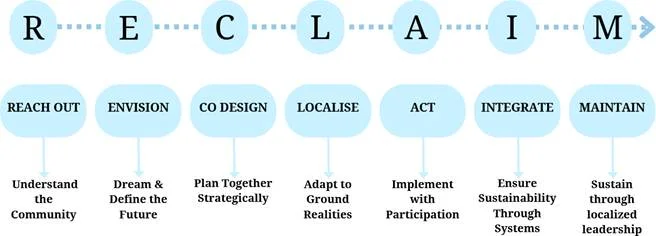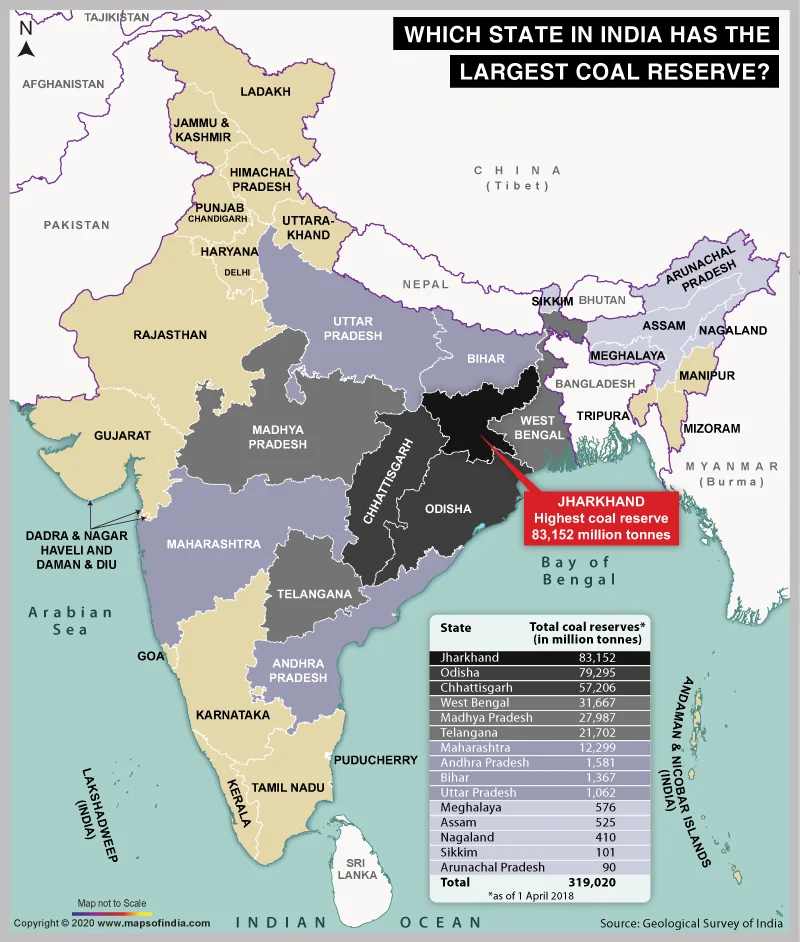Facts for UPSC Mains
RECLAIM Framework for Mine Closure
- 05 Jul 2025
- 7 min read
Why in News?
The Ministry of Coal launched the RECLAIM Framework to ensure just and sustainable mine closures through inclusive community participation.
What is RECLAIM Framework?
- About: An India-specific policy tool developed by the Coal Controller Organisation (Ministry of Coal) in partnership with the Heartfulness Institute, aimed at guiding inclusive and sustainable mine closures.
- Objective: To ensure a just, inclusive, and locally relevant transition for mining-affected communities by promoting community participation, ecological restoration, and long-term socio-economic recovery.
- It focuses on gender inclusivity, vulnerable groups, and convergence with Panchayati Raj Institutions to build resilient post-mining economies.
- Key Features:
- It promotes community-centric planning through local participation, with emphasis on gender equity, vulnerable groups, and livelihood diversification.
- It ensures institutional convergence by aligning with Panchayati Raj Institutions and local governance structures, and provides actionable, field-tested tools and methodologies tailored to Indian mining regions for effective implementation.
- Phases of Implementation: Pre-Closure (needs assessment, capacity building), Closure (participatory plan execution), and Post-Closure (monitoring, livelihood support, asset repurposing).
- Significance:
- Mitigates socio-economic and environmental impacts of mine closures
- Supports SDGs and promotes transparency, accountability, and trust
- Serves as a replicable model for other resource-dependent sectors and states.
What are the Key Challenges Related to Coal Mine Closure?
- Gap Between Policy and Practice: Despite mine closure guidelines since 2009, only 3 coal mines have been formally closed.
- Of the 299 non-operational mines (2024), only 8 applied for closure, while the rest remain abandoned or discontinued without scientific closure, causing ecological degradation, methane emissions, and increased risks of accidents and illegal mining.
- Lack of Proper Rehabilitation: Unsustainable mining and degradation of local resources have led to unemployment and forced migration, reducing community capacity and resource availability during mine closure. This hampers local participation and poses a major challenge to implementing effective and inclusive closure.
- Lack of Land Return Framework: The lack of clear mine closure and land return policies often results in land being transferred to other departments or used for renewable projects without scientific closure or community consultation, delaying just transition efforts, especially in states like Jharkhand.
- The 2024 draft Coal Bearing Areas (CBA) Amendment Bill proposes returning unused land to original owners, but lacks enforcement clarity.
- Technological & Economic Challenges: India's mine closure plans are mostly technical, neglecting social, economic, and environmental justice aspects.
- High escrow requirements (Rs 14 lakh/ha for opencast mines) deter mine operators from undertaking closure activities.
About Coal
- About: Coal is a fossil fuel formed from the remains of ancient vegetation, found in the form of sedimentary rock, and often referred to as 'Black Gold' due to its high economic value.
- It is a conventional energy source widely used for domestic fuel, thermal power generation, and in industrial sectors like iron and steel and railway steam engines.
- Global Producers: As of 2025, top 5 coal-producing countries are China, India, Indonesia, United States and Russia.
- Coal Distribution in India:
- Gondwana Coal Fields: Gondwana coal contributes 98% of India’s coal reserves and 99% of its production, providing superior and metallurgical-grade coal.
- Major deposits are in the Damodar (Jharkhand–West Bengal), Mahanadi (Chhattisgarh–Odisha), Godavari (Maharashtra), and Narmada (Madhya Pradesh) valleys.
- Tertiary CoalFields: Tertiary coal fields (15–60 million years old) have lower carbon content but are rich in moisture and sulphur.
- They are mainly found in extra-peninsular regions such as Assam, Meghalaya, Nagaland, Arunachal Pradesh, Jammu & Kashmir, Darjeeling foothills (West Bengal), Rajasthan, Uttar Pradesh, and Kerala.
- Gondwana Coal Fields: Gondwana coal contributes 98% of India’s coal reserves and 99% of its production, providing superior and metallurgical-grade coal.
- Classification of Coal:
- Anthracite (80–95%): Highest carbon content, limited presence in Jammu & Kashmir.
- Bituminous (60–80%): Most abundant, found in Jharkhand, Odisha, Chhattisgarh, West Bengal, and Madhya Pradesh.
- Lignite (40–55%): Lower grade, high moisture, found in Tamil Nadu, Rajasthan, and Assam (Lakhimpur).
- Peat (<40%): Initial stage of coal formation with low heating value.
|
Drishti Mains Question: Critically analyse the socio-economic and ecological consequences of unscientific coal mine closures in India. How does the RECLAIM Framework aim to address these issues? |
UPSC Civil Services Examination Previous Year Question (PYQ)
Prelims
Q1. Consider the following statements: (2019)
- The coal sector was nationalized by the Government of India under Indira Gandhi.
- Now, coal blocks are allocated on lottery basis.
- Till recently, India imported coal to meet the shortages of domestic supply, but now India is self-sufficient in coal production.
Which of the statements given above is/are correct?
(a) 1 only
(b) 2 and 3 only
(c) 3 only
(d) 1, 2 and 3
Ans: (a)
Mains
Q. Despite India being one of the countries of Gondwanaland, its mining industry contributes much less to its Gross Domestic Product (GDP) in percentage. Discuss. (2021)
Q. “In spite of adverse environmental impact, coal mining is still inevitable for development”. Discuss. (2017)








